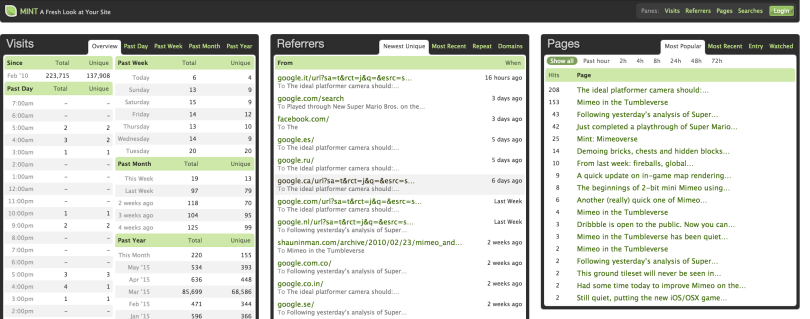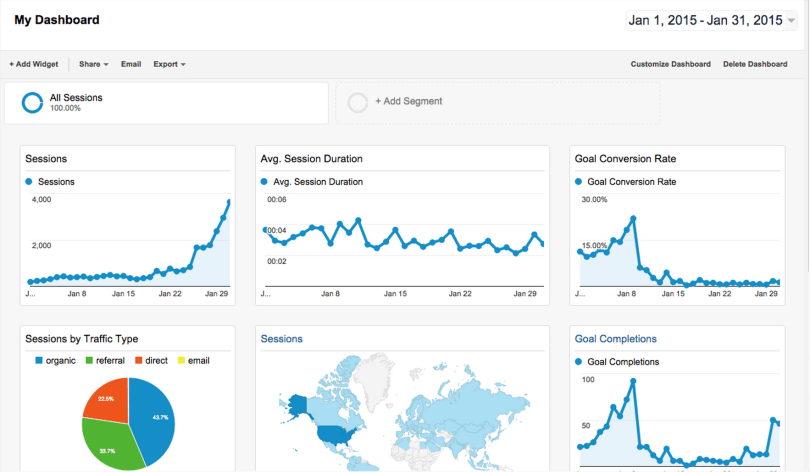
What Can I Expect My Business Brochure Site to Deliver in 100 Days?
The launch of a new business brochure site is an exciting time for any site owner, but it brings with it uncertainty and doubt.
It can be difficult to have a clear set of expectations in place about what your site should be achieving straight out of the gate, and all too often it’s assumed that launching is the end of the story rather than the beginning.
The first few months of a site’s life are critical for establishing momentum and setting the scene for what will hopefully be long-term success. There is much initial post-launch work to be done.
In this article we’ll cover what you can reasonably expect your new business brochure site to deliver within its first 100 days and what you need to pay particular attention to in order to ensure your goals are met.
Let’s begin with some items you need to be certain are adequately covered prior to the launch itself.
Business Prerequisites
As most business owners and site developers will have learned the hard way, web sites are not magic bullets. All a site can ever hope to do is amplify or build on processes, people and priorities that are already in place.
You’ll need the following items squared away before you can expect to launch a site with any sort of success:
- A defined product or service: It may sound stunningly obvious that you need to define what product or service you will offer, but the list of people who have attempted to launch a site without doing so is not a short one.
- Market understanding: Once you are clear on the value you’re potentially bringing to the table, it’s imperative that you have an understanding of the wider context your site will be operating in.
- Runway: Pinning all your hopes on a new site delivering significant money from the off is a shortcut to disaster and disappointment. You need contingency funds in place to get through the first few months.
Website Prerequisites
The sad fact for many new site owners is that the first three to six months of their site’s existence are spent repairing critical but easily avoidable mistakes that were made during the initial build. For the purposes of this article, we’re assuming you have the following list covered:
- Reliable hosting: Any WordPress site can struggle under heavy load. Your chances of hitting that load at the outset are remote. Early-stage outages are an excellent sign you’ve picked the wrong hosting partner, site developer, or both.
- Mobile-friendly site: Mobile matters. A condition of signing-off on the initial site build should be that it functions perfectly on all mobile devices.
- A functional blog: Your site’s blog will be the cornerstone of your initial content building. This has to be in place from day one.
- Analytics: Analytics should be in place and tested from the outset so you know exactly how your site is performing.
- Core content: We’ve already covered the core content any business brochure site should have here on the blog. Make sure your site is ticking the right boxes.
- On-site SEO: Snake-oil and smoke and mirrors aside, the basics of on-site SEO are broadly agreed on in 2015. Make sure your site arrives fit for purpose out of the box.
It’s All About Leads
Let’s cut to the chase – the primary task of your site in the first 100 days is to establish itself as a reliable source of high-quality leads.
Traffic, Facebook fans, “engagement” – all of these things are ultimately irrelevant unless you are consistently getting potentially paying customers through the virtual door.
Using your newly launched site as a laboratory, you need to get a handle on the core numbers that will define the future success or failure of your business:
- Lead acquisition rate: The percentage of your site traffic that hand over meaningful contact details.
- Lead conversion rate: The percentage of those leads you are turning into revenue.
- Customer value: The average amount a new customer is worth.
By the end of the first 100 days, you want to have a clear idea of what those three numbers are. Their respective values, when considered in the overall context of your business, will tell you how effective both your site and your sales processes are and point the way to potential future improvements.
If you have the funds to pursue it as an option – and if it makes sense in the context of your target market – it’s worth starting with some sort of paid lead acquisition strategy such as Adwords or Facebook ads to get a handle on those numbers as early as possible.
You’ll obviously want to be tracking your leads from the outset and providing appropriate lead magnets to encourage your users to contact you as much as possible.
What sort of numbers should you be shooting for here? It’s obviously impossible to provide answers that will fit all scenarios, but research across a huge number of online users by Formstack suggests that a 7% lead acquisition rate is a good lower limit to aim for.
If you’re not hitting this by the three month mark it’s time for a serious rethink.
Building Momentum
As we mentioned, if you’re in a position to use Search Engine Marketing to prime the pump early on then by all means do so. You will also want to be sure you are covering your bases in other areas to set your site up for future success – and the first 100 days is a critical time period in this respect. Let’s look at some key areas.
Content Creation and Link Building
Search engines want to see content appearing on some sort of regular schedule on your site before they start paying any attention to it.
Your resources in this area will vary depending on your staffing and ability but consider breaking down your initial content strategy for 100 days as follows:
- 1-10: Identify relevant keyword topics for your business and come up with content types you are confident you can produce on a schedule.
- 10-20: Start production and aim for a minimum of one new content piece per week.
- 20-50: Keep churning it out. Review performance at the 50 day mark and double down on whatever is working.
- 50-100: More production allied to organized link outreach based on the content you have created so far, and overall market and competitor research.
Figures will naturally vary wildly across different market niches but you should be expecting to hit over 30% of your site traffic from organic search as a result of your efforts by the end of the first 100 days.
Promotions
You only really get to launch a completely new site once and it’s a natural time for tying in some sort of launch promotion or giveaway to attract initial attention.
Look to run at least one high-profile promotion in the first 100 days of your site to build buzz, and aim for one smaller monthly giveaway to keep interest up among your audience.
Social Media
The first key action item you should be hitting in regards to a social strategy for your site in the first 100 days is simply mapping the relevant space for your industry. Draw up initial lists of the 50 to 100 most influential accounts in your market and make sure you are following them.
If it makes sense in the context of your business it could be worth splitting these initial target lists between global and local sources, as you probably have a much better chance of useful interaction with the latter.
Step two is then promoting your content and promotions as actively as possible via your chosen channels.
Don’t make the mistake of getting hung up on hitting particular numbers in terms of followers or fans by the 100 day mark. What counts in that first period is providing value, getting real conversations going with people and starting to see verifiable leads arrive via this channel.
Measurement and Tweaking
As you can see from the points above, the first 100 days will be busy ones for you and your team. It’s important to stress that many of the numbers you see early on for your site may not be particularly meaningful on their own and you should be aiming for action over analysis throughout.
It’s very easy to waste time at the beginning of a site’s life in obsessively checking and rechecking vanity metrics such as pageviews rather than building meaningful content for your users.
We suggest the following broad strategy for the first 100 days:
- Key site metrics: Track overall traffic and conversions by channel with the focus on conversions. Review weekly rather daily. Check traffic sources and top performing content on a monthly basis.
- Key business metrics: Track how many leads came in through the site and how well you are converting those leads into sales. Nothing else matters.
- Review phases: Set defined weekly, monthly and quarterly review phases that you use to drive decisions rather than falling prey to the temptation to reactively tweak when the mood strikes you.
You can use a tool such as Mint for your analytics. For a monthly fee, Mint will provide you with a slew of numbers for your site:
Alternatively, there’s Google Analytics – probably the most popular analytics tool. Aside from being free to use, they provide a lot of data on your given site. Here is an example Google Analytics dashboard:
Conclusion
Over-emphasizing concrete numbers as goals in the first few months of a site’s life is a risky business. Devoid of any meaningful context to compare with, they can often serve as little more than hopeful guesses.
Your overall goal for the first 100 days should be the establishment of your site as a predictable source of quality leads.
How that expresses itself numerically will depend on the nature of your business. Concentrate on the following items to keep moving in the right direction throughout:
- Make lead acquisition and conversion your primary meaningful metrics.
- Get your content and social media engines up and running.
- Stay focused on action rather than analysis.
We’re curious to hear how you handled the first 100 days of your own site and what takeaways or tips you gathered along the way. Let us know in the comments below!
Liked the article? You should follow me on Twitter





certainly like your web-site however you need to check the spelling on quite a few of your
posts. Several of them are rife with spelling problems and I find it very bothersome to tell the truth nevertheless I will definitely come again again.